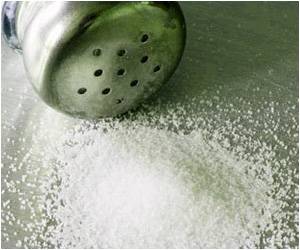High sodium intake from a variety of foods makes American children vulnerable to heart disease later in life. Reducing salt intake can prevent disease later in life.

‘The average sodium intake for children was 3,256 milligrams per day, not including any salt added at the table.’





“Sodium reduction is considered a key public health strategy to reduce the risk of cardiovascular diseases nationwide and this study is the latest in ongoing CDC efforts to monitor U.S. sodium intake,” explained lead author Zerleen S. Quader, MPH, a data analyst with the Centers for Disease Control and Prevention (CDC) Division for Heart Disease and Stroke Prevention. “We already know that nearly all Americans regardless of age, race, and gender consume more sodium than is recommended for a healthy diet and the excess intake is of great concern among particular youths.”Using data from the 2011-2012 National Health and Nutrition Examination Survey (NHANES), CDC researchers looked at the eating habits of 2,142 children between the ages of 6 and 18 years. They found that the average sodium intake for kids was 3,256 milligrams per day, not including any salt added at the table. The recommended intake for children varies from 1,900 mg/day to 2,300 mg/day depending on age. Nearly 90% of the children surveyed exceeded the upper level of sodium recommended for their age group and previous evidence suggests that one in nine children ages 8-17 years already has blood pressure above the normal range for their age, sex, and height, which increases their risk of high blood pressure as adults.
The study also found that high levels of sodium were being consumed throughout the day and from a variety of different sources. For example, they found 39% of sodium was consumed at dinner, 31% came from lunch, 16% from snacks, and 14% at breakfast. Researchers discovered that only 10 types of food made up almost 50% of kids’ sodium intake. These included pizza, Mexican mixed dishes, sandwiches (including burgers), bread, cold cuts, soups, savory snacks, cheese, plain milk, and poultry.
Looking at where sodium-laden foods were purchased, researchers found that foods from the grocery store accounted for a substantial 58% of daily sodium intake, while fast-food/pizza contributed 16%, and the school cafeteria 10%. “With the exception of plain milk, which naturally contains sodium, the top ten food categories contributing to U.S. school children’s sodium intake in 2011-2012 comprised foods in which sodium is added during processing or preparation,” said Quader. “Sodium is consumed throughout the day from multiple foods and locations, highlighting the importance of sodium reduction across the U.S. food supply.”
While sodium intake exceeded daily recommended levels across the board, the study found that average levels were even higher for teens ages 14-18 years (3,565 mg/day vs. 3,256 mg/day for all ages) and that girls had significantly lower daily intake than boys (2,919 mg/day for girls vs. 3,584 mg/day for boys); however, no significant differences in mean sodium intake were observed by race/ethnic group, household income, or child weight status.
Advertisement
The investigators have identified some important tips for parents and caregivers looking to help cut down sodium in kids’ diets:
- Feed your children a diet rich in fresh fruits and vegetables without added sodium or sauces.
- Read nutrition labels. When shopping at the grocery store, look for the lowest sodium options for your child’s favorite foods. An easy way to assess sodium in a food is to focus on the amount of sodium per serving. Those foods with less than 140 mg per serving are considered low in sodium.
- Request nutritional information at restaurants to find healthier options. Speak with your local grocer about stocking lower-sodium versions of foods.
Advertisement
Source-Newswise










